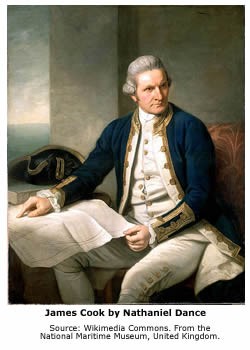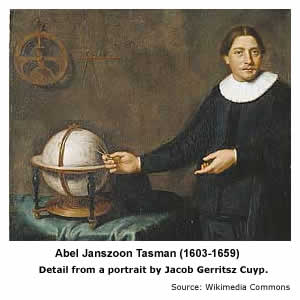Before 1788 and the Captain Cook Discoveries.
The concept of a ‘Terra Australis Incognito,’ a great south land, existed in Europe’s middle ages as a myth. The belief was that, a southern land mass acted as a balance, to the northern hemisphere lands. During the ‘age of discovery’ the main seafaring countries, England, the Netherlands, Portugal and France, lead exploratory expeditions across the world’s oceans. It was the explorers of ‘die Niederlande’ that contributed much to the discovery of Australia’s west coast, as they had dominance of the trade routes to the East Indies. Many German speaking sailors were part of these crews, recruited by the Dutch East India Company which visited the western coast after 1605.

New Holland’ (Australia) proved to be separate from New Guinea. In 1606 the Dutch yacht “Dufken” (Little Dove) commanded by Willem Jansz, sailed into the Torres Strait. This is possibly the first contact that the indigenous population had with Europeans; the Aborigine population of ‘New Holland’ having been in contact with Asian seafarers for many years.
In 1616 the Dutchman, Dirk Hartog and his crew were purported to have been the first to set foot in New Holland. After repairing his ship and before setting sail, he hammered his now famous pewter plate on to the western continent. In 1642 Abel Tasman with Yde Jercxzoon (who was born in Jever, Germany) sailed the southern Pacific oceans and southern Australia. He named Tasmania after himself and then discovered and named Storm Bay. Abel Tasman then sailed on to New Zealand.
In 1688 William Dampier was beached in ‘New Holland’, where he overhauled his ship the “Cygnet”. In 1696 the Dutch commander Vlaming named the Swan River. Over the span of 80 years of exploration ‘New Holland’ was never claimed as a land or colony of any of the kingdoms of the Netherlands, or other Germanic principalities.
As described in my first article, Germanic Migration, which was published in the January issue of FTF Magazine, the French revolution of 1789 and the Napoleonic wars of 1799-1815 saw not only refugees fleeing to England, but many young German men fleeing from the invading French armies and taking ships to England. Many were pressed into the service of the English army and navy; many more volunteered their services to retrieve their homelands.
The Hanoverian army escaped the French troops en bloc and in 1803 served as the King’s German Legion. King George III, also elector of Hanover, had strong ties to this northern German principality. When Hanover was freed in 1815 many of the troops returned home to German soil. Although many also accepted land grants in the English colonies, firstly in America and, after American Independence, in the colonies of New South Wales.
The famous Hessian and Waldecker forces had also fought for England in the American Revolutionary Wars of 1775–1815. Many of these German speakers arrived onto Australian shores, some as part of the garrison and others as emigrants hoping for land grants that were freely given out. One of the first three people to be given land for free cultivation was Phillip Schaeffer who had been a lieutenant in the Hessen regiment. Schaeffer came from Hessen in Germany and had arrived in Sydney in 1790. Sadly, he became an alcoholic and died in the colonial poorhouse.
England’s part in the discovery of ‘New Holland’ took on greater importance with the loss of its American colonies in 1776. The huge cost of war and the overcrowding of English cities (especially London, added to by streams of refugees) and the need to accommodate larger and larger numbers of convicted criminals made the Tory government of Lord North take notice of the discovery of New South Wales. None of the Netherlands’ captains had claimed the lands of the ‘new found land’ for their governments; it was perceived that this parched continent had neither inherent wealth nor was suitable for agriculture. The south land of ‘New Holland’ was still unclaimed.
In 1768, George III commissioned Captain James Cook to lead an expedition into the Pacific ocean. Cook discovered the east coast of Australia and the Great Barrier Reef of the north eastern part of the continent. Captain Cook discovered the sheltered coves which he named Port Jackson and Botany Bay, which both him and Sir Joseph Banks deemed perfect for settlement. Here he planted the English flag and clamed the land for England, naming all of the eastern continent (of Australia) New South Wales. Upon his return to England, Cook was presented to George III. He made two more expeditions, one to Antarctica during 1772 to 1775, and his third voyage to Honolulu where he was killed.
A certain Heinrich Zimmerman sailed with Cook. Previously a ‘jack-of–all trades’ he went ashore at Adventure Bay, Tasmania in January 1777. Heinrich Zimmermann came from Wissloch, in the Pfalz region of Germany. He recorded and later published a book in 1781 that included names of other German sailors and adventurers, including the sculpture Johann Waeber and his son the illustrator Johann Waeber jnr. The Waebers, on their return to London, published more than 200 paintings and drawings which made them quite wealthy and gave them some fame.
England now had a new colony. In 1788 Captain Arthur Phillip arrived to begin settlement of a penal colony. Captain Arthur Phillip was commander of the First Fleet and became the first governor of the colony of New South Wales and established the settlement at Sydney Cove. It is interesting to note that Captain Arthur Phillip’s father was a German. Jacob Phillip had been born in Frankfurt but was a teacher of languages in London.

Another German of note was the founder of the settlement of Parramatta, Augustus Theodor Henry Alt. Augustus Alt had graduated from Marburg University in 1748. He was the first Land Surveyor-General of the colony of New South Wales, and played an important part in the planning of the township of Sydney.
Quite a few German convicts arrived at the New South Wales colony. They arrived from Britain from where they had migrated in the hope of a better life, but had found themselves in the penal colony with many others.
On board ‘The Active’ in 1791 was Bernard Walford. He was an engraver from Vienna who had moved to London. Walford was convicted of stealing a basket of washing in Pettycoat Lane and was sent to the penal settlement of Norfolk Island. After doing his time he married an Irish woman and went to Hobart where both became model citizens.
Then there was Joseph Marcus, born in Mannheim, Germany, who had moved to Staffordshire in England where he was convicted for breaking and entering. He arrived in the penal colony as a convict in 1792. And there was one Gustav Kissler, born in Saxony, who worked as a bookseller in London. He was transported to Australia for receiving stolen property.
As time went on, more free settlers also arrived in the colony. Those that could secure passage to be with convicted family members did so, to begin a new life. Others joined the men in the regiments or to find adventures and seek their fortune.
In 1801 the Austrian botanical artist Ferdinand Lukas Bauer was chosen by Sir Joseph Banks to accompany Mathew Flinders on his historic circumnavigation of the Australian continent. Bauer made about 2000 sketches and drawings which he sent to England. These are in the British Museum and in the Naturhistorisches Museum in Vienna. Johann Wolfgang von Goethe admired these sketches and considered Bauer to be one of the greatest botanical artists of all time. A parrot species was named after Bauer. Mathew Flinders named Cape Bauer near Streaky Bay in South Australia after him too.
In 1840 to 1842 the maturing colony had Sir William Hampton Dutton appointed as its first Consul General. His brother Pelham Dutton held the post from 1844 to 1847. Usually consuls were people with a German background. As a young man Sir William travelled a lot in Germany and attended university classes in Prussia.
In 1855, the British German Legion which was stationed at Shorncliffe in Kent, Aldershot in Hampshire and Colchester in Essex was made up of Germans and Belgians. From here, soldiers, merchants, explorers, missionaries, sea men and civil servants were all attracted to a fresh start in Australia.
Delightful Dukkie
© Delightful Dukkie 2008